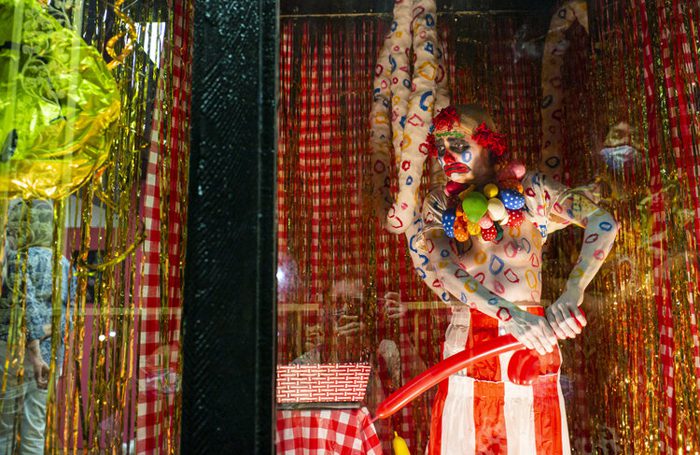Live in America features under-recognized Southwest cities, such as Albuquerque, Ciudad Juárez, Mexico, El Paso, Texas, and Las Vegas, Nevada, in a debut performance festival in Northwest Arkansas.

LAS VEGAS, NV—Over the course of nearly two weeks in June, performance artists from all over the country—including inventive creatives in the Southwest—will travel to the town of Bentonville, Arkansas to present works that capture the sense of their cities.
The inaugural Live in America festival is a project over a year in the making, with several date changes due to the pandemic. The event, organized and sponsored by the Fusebox Festival of Austin, Texas and The Momentary, an offshoot of the Crystal Bridges Museum of American Art in Bentonville, is scheduled to take place from June 2 through June 12, 2022 at The Momentary. The event, which will highlight issues in Southwestern locales that are often overlooked by the larger contemporary art world, will include an interactive Las Vegas, Nevada-style casino, sans the manufactured veneer that one might find on the Strip, and an Albuquerque group of artists that are bringing attention to the queer Indigenous movement.
Northwest Arkansas has gained national attention through Crystal Bridges, but the mega-museum with ties to Walmart (which is headquartered in Bentonville) isn’t the only creative game in town. The area has hosted several performance events, including the Inverse Performance Art Festival, put together by Cynthia Post Hunt, who serves as a Live in America festival organizer alongside a team of artists across the country.
Another key facilitator of the project is Justin Favela, a Las Vegas-based artist who’s known for his piñata-inspired installations and sculptures. When Vegas was chosen as a festival representative, Favela enlisted organizer Wendy Kveck as co-facilitator for the Las Vegas contribution. Performers Adriana Chavez and Heidi Rider serve as producers on the project.
The Las Vegas artist group opens the festival on June 2, 2022, and promises to bring the spectacle with Enter the Night. “We are going all out,” says Favela, a recent Joan Mitchell Fellowship awardee. From a city known for its high stakes and flashy entertainment, the artists plan to present the high energy and spectacle of the Las Vegas Strip with an earnest desire to entertain.

The Las Vegas performers will activate all three floors of The Momentary, setting up cardboard signs, projection mapped casino floors, and interactive slot machine-type games to create a homemade Vegas simulacrum. Favela will act as an Elvis impersonator who has seen better days, showing a more humorous, less polished side of the Vegas Strip. Rider, who also works as an Elvis officiant and clown on the Strip, will make balloon animals from the top of the building before dropping them to the floors below. Chavez, as her itinerant everyman character Juan Chico, will roam the floors of the “casino” picking up trash and cleaning up after guests, showing the labor required to keep the illusion of perfection.
Posted up outside in a barker-like role is Brent Holmes, a performance artist known for a larger-than-life personality. Wearing cowboy gear, Holmes, whose recent work explores the history of race in the West, will be asking passers-by to gamble and win big, using their secrets as currency. Holmes is also a contributor to the Las Vegas performance art scene, running a recurring performance art night called Radar.
The imitative Vegas fits right into the festival’s site as a former Kraft cheese factory. Velveeta is the Vegas of cheese: it’s not quite real, but oddly palatable and efficient. Las Vegas locals are similarly authentic, even when pretending. “A façade is our reality,” says Favela. “We are used to listening to expectations and making things accessible.”
To represent Ciudad Juárez, Mexico/El Paso, Texas, artists have come together to tell the story of the border through a multidisciplinary sound-based performance titled El Puente, or The Bridge. The sound work is “inspired by the natural, mechanical, and human sounds of our border,” says facilitator Edgar Picazo Merino. The border serves as the connector for the work, which involves spoken word, dance, music, and acting. With high anticipation, this performance has already sold out.
Meanwhile, artists from Albuquerque will present Pop-Up Powwow on Sunday, June 12. The performance brings together a group of intergenerational two-spirit/Indigiqueer artists with the goal to form a visible place within the community. The performers come from a range of Indigenous nations across Turtle Island, and include the Pueblo, Diné, Hopi, and Apache nations of Albuquerque. In advance of the presentation, the performers and organizers conducted conversations around the importance of a queer Indigenous movement—not of visibility, but of community investment.

The festival, which brings together more than 300 artists, allows many underheard communities and artists to present their works to a national audience in their own voices and in the context of contemporary performance. This is important for cities like Las Vegas and El Paso-Juárez, where the publicized images of Sin City, or violent border towns, monopolize the national imagination. In reality, our Southwest experiences are not so easily condensed.
Live in America is scheduled to take place June 2 through June 12, 2022 at The Momentary, 507 SE E Street in Bentonville, Arkansas. Event and ticket information, as well as video interviews with artists and writing on the projects, can be found at the Live in America website.




